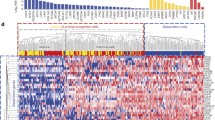Summary
The rat tumor cell lines BSp73AS (AS, nonmetastasizing with pronounced adherent capacities) and BSp73ASML (ASML, highly metastasizing with reduced adherent capacities) were cytogenetically investigated. The ASML cell line.is reportedly derived from the AS cell line. Both lines exhibited abnormal numerical and structural chromosomal characteristics. The metastasizing ASML cells showed a higher chromosome number (modal number: 62–63) than the nonmetastasizing AS cells (modal number: 48).
The AS karyotype was characterized by the presence of a large metacentric marker chromosome resulting from a Robertsonian translocation (Rb 6.7). This chromosome is as such absent in ASML cells but perhaps it may be present in these cells with a major part of chromosome 7 being deleted.
The most interesting feature of the ASML karyo-type was the presence of double minutes (DMs) and a homogeneously staining region (HSR) at the telomeric end of chromosome 6. These were peculiar to the ASML cells, being absent in the AS cells. DMs and HSR are reported to be correlated with the resistance to various drugs and with the acquired virulence of tumor cells through gene amplification.
Therefore, we assume that in the metastasizing ASML cell line the DMs and HSR were established through genetic selection and that they are probably related to the acquired metastasizing capacity of these cells.
Similar content being viewed by others
References
Alitalo K, Schwab M, Lin CC, Varmus HE, Bishop JM (1983) Homogeneously staining chromosomal regions contain amplified copies of an abundantly expressed cellular oncogene (cmyc) in malignant neuroendocrine cells from a human colon carcinoma. Proc Natl Acad Sci USA 80:1707–1711
Aulenbacher P, Werling HO, Paweletz N, Spiess E (1984) Invasive activities of metastasizing and non-metastasizing tumor cell variants in vitro. Anticancer Res (in press)
Balaban-Malenbaum G, Gilbert FW (1977) Double minute chromosomes and the homogeneously staining regions in chromosomes of human neuroblastoma cell lines. Science 198:739–741
Bosman HB, Hall TC (1974) Enzyme activity in invasive tumors of human breast and colon. Proc Natl Acad Sci USA 71:1833–1837
Committee for a Standardized Karyotype ofRattus norvegicus (1973) Standard karyotype of the Norway rat,Rattus norvegicus. Cytogenet Cell Genet 12:199–205
Cooper AG, Codington JF, Brown MC (1974) In vivo release of glycoprotein I from the Ha subline of TA3 murine tumor into ascites fluid and serum. Proc Natl Acad Sci USA 71:1224–1228
Cowell JK (1980) A new chromosome region possibly derived from double minutes in an in vitro transformed epithelial cell line. Cytogenet Cell Genet 27:2–7
Cowell JK (1982) Double minutes and homogeneously staining regions: gene amplification in mammalian cells Annu Rev Genet 16:21–59
George DL, Francke U (1980) Homogeneously staining regions and double minutes in a mouse adrenocortical tumor cell line. Cytogenet Cell Genet 28:217–226
George DL, Powers VE (1982) Amplified DNA sequences in Y1 mouse adrenal tumor cells: association with double minutes and localization to a homogeneously staining chromosomal region. Proc Natl Acad Sci USA 79:1597–1601
Ghosh S, Ghosh I (1969) Chromosomal alterations in the evolution of substrains of the Ehrlich-Lettré-Mouse ascites tumor. Chromosoma 28:62–72
Hsu TC, Benirschke K (1967)Rattus norvegicus (Rat). In: An atlas of mammalian chromosomes, vol 1. Springer, New York, p 18
Hynes RO (1976) Cell surface proteins and malignant transformation. Biochim Biophys Acta 458:73–107
Levan G (1974) Nomenclature for G-bands in rat chromosomes. Hereditas 77:37–52
Levan A, Levan G, Mitelman F (1977) Chromosomes and cancer. Hereditas 86:15–30
Matzku S, Komitowski D, Mildenberger M, Zöller M (1983) Characterization of BSp73, a spontaneous rat tumor and its in vivo selected variants showing different metastasizing capacities. Invasion Metastasis 3:109–123
Nicolson GL (1982) Cell surfaces and cancer metastases. Hosp Pract 17:75–86
Nunberg J, Kaufman R, Schimke R, Urbaub G, Chasin L (1978) Amplified dihydrofolate reductase genes are localized to a homogeneously staining region of a single chromosome in a methotrexate-resistant Chinese hamster ovary cell line. Proc Natl Acad Sci USA 75:5553–5556
Quinn LA, Moore GE, Morgan RT, Woods LK (1979) Cell lines from human colon carcinoma with unusual cell products, double minutes and homogeneously staining regions. Cancer Res 39:4914–4924
Schimke RT (1982) Studies on gene duplication and amplifications — An historical perspective. In: Schimke RT (ed) Gene amplification. Cold Spring Harbor Laboratory, New York, pp 1–9
Schirrmacher V, Altevogt, P, Fogel M, Dennis J, Waller CA, Barz D, Schwarz R, Cheingsong-Popov R, Springer G, Robinson PJ, Nebe T, Brossmer W, Vlodavsky I, Paweletz N, Zimmermann HP, Uhlenbruck G (1982) Importance of cell surface carbohydrates in cancer cell adhesion, invasion and metastases. Invasion Metastasis 2:313–360
Schwab M, Alitalo K, Varmus HE, Bishop JM, George D (1983) A cellular oncogene (c-Ki-ras) is amplified, overexpressed, and located within karyotypic abnormalities in mouse adrenocortical tumour cells. Nature 303:497–501
Seabright M (1971) A rapid banding technique for human chromosomes. Lancet II:971–972
Unakul W, Hsu TC (1972) The C- and G-banding patterns ofRattus norvegicus chromosomes. J Natl Cancer Inst 49:1425–1428
Yoshida TH (1955) Origin of V-shaped chromosome occurring in tumor cells of some ascites sarcomas in the rat. Proc Jpn Acad 31:237–242
Yoshida TH (1983) Karyotype evolution and tumor development. (Review article) Cancer Genet Cytogenet 8:153–179
Werling HO, Aulenbacher P, Spiess E, Paweletz N, Friedrich E (1983 a) Characterization of the morphology and cell interaction capacity of spontaneous rat tumor cell variants. J Cancer Res Clin Oncol 105:A15
Werling HO, Spiess E, Aulenbacher P (1983b) Scanning electron microscopy of spontaneous rat tumor cell variants. Eur J Cell Biol S2:43
Author information
Authors and Affiliations
Rights and permissions
About this article
Cite this article
Werling, H.O., Ghosh, S. & Spiess, E. Chromosome analysis of two rat tumor cell lines possible role of DMs and HSR in metastasis. J Cancer Res Clin Oncol 107, 172–177 (1984). https://doi.org/10.1007/BF01032603
Received:
Accepted:
Issue Date:
DOI: https://doi.org/10.1007/BF01032603




